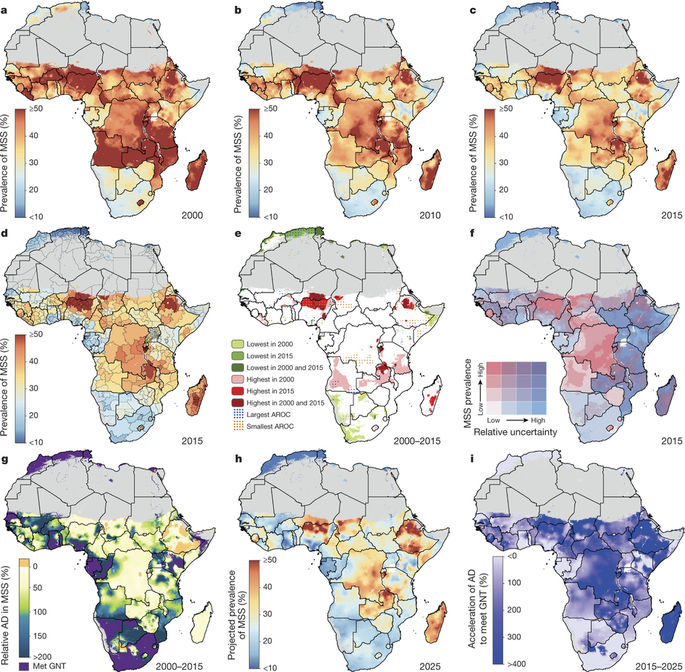Our official English website, www.x-mol.net, welcomes your
feedback! (Note: you will need to create a separate account there.)
Mapping child growth failure in Africa between 2000 and 2015
Nature ( IF 50.5 ) Pub Date : 2018-03-01 , DOI: 10.1038/nature25760 Aaron Osgood-Zimmerman 1 , Anoushka I Millear 1 , Rebecca W Stubbs 1 , Chloe Shields 1 , Brandon V Pickering 1 , Lucas Earl 1 , Nicholas Graetz 1 , Damaris K Kinyoki 1 , Sarah E Ray 1 , Samir Bhatt 2 , Annie J Browne 3 , Roy Burstein 1 , Ewan Cameron 3 , Daniel C Casey 1 , Aniruddha Deshpande 1 , Nancy Fullman 1 , Peter W Gething 3 , Harry S Gibson 3 , Nathaniel J Henry 1 , Mario Herrero 4 , L Kendall Krause 5 , Ian D Letourneau 1 , Aubrey J Levine 1 , Patrick Y Liu 1 , Joshua Longbottom 3 , Benjamin K Mayala 1 , Jonathan F Mosser 1 , Abdisalan M Noor 6, 7 , David M Pigott 1 , Ellen G Piwoz 5 , Puja Rao 1 , Rahul Rawat 5 , Robert C Reiner 1 , David L Smith 1 , Daniel J Weiss 3 , Kirsten E Wiens 1 , Ali H Mokdad 1 , Stephen S Lim 1 , Christopher J L Murray 1 , Nicholas J Kassebaum 1, 8 , Simon I Hay 1, 3
Nature ( IF 50.5 ) Pub Date : 2018-03-01 , DOI: 10.1038/nature25760 Aaron Osgood-Zimmerman 1 , Anoushka I Millear 1 , Rebecca W Stubbs 1 , Chloe Shields 1 , Brandon V Pickering 1 , Lucas Earl 1 , Nicholas Graetz 1 , Damaris K Kinyoki 1 , Sarah E Ray 1 , Samir Bhatt 2 , Annie J Browne 3 , Roy Burstein 1 , Ewan Cameron 3 , Daniel C Casey 1 , Aniruddha Deshpande 1 , Nancy Fullman 1 , Peter W Gething 3 , Harry S Gibson 3 , Nathaniel J Henry 1 , Mario Herrero 4 , L Kendall Krause 5 , Ian D Letourneau 1 , Aubrey J Levine 1 , Patrick Y Liu 1 , Joshua Longbottom 3 , Benjamin K Mayala 1 , Jonathan F Mosser 1 , Abdisalan M Noor 6, 7 , David M Pigott 1 , Ellen G Piwoz 5 , Puja Rao 1 , Rahul Rawat 5 , Robert C Reiner 1 , David L Smith 1 , Daniel J Weiss 3 , Kirsten E Wiens 1 , Ali H Mokdad 1 , Stephen S Lim 1 , Christopher J L Murray 1 , Nicholas J Kassebaum 1, 8 , Simon I Hay 1, 3
Affiliation

|
Insufficient growth during childhood is associated with poor health outcomes and an increased risk of death. Between 2000 and 2015, nearly all African countries demonstrated improvements for children under 5 years old for stunting, wasting, and underweight, the core components of child growth failure. Here we show that striking subnational heterogeneity in levels and trends of child growth remains. If current rates of progress are sustained, many areas of Africa will meet the World Health Organization Global Targets 2025 to improve maternal, infant and young child nutrition, but high levels of growth failure will persist across the Sahel. At these rates, much, if not all of the continent will fail to meet the Sustainable Development Goal target—to end malnutrition by 2030. Geospatial estimates of child growth failure provide a baseline for measuring progress as well as a precision public health platform to target interventions to those populations with the greatest need, in order to reduce health disparities and accelerate progress.
中文翻译:

绘制 2000 年至 2015 年非洲儿童生长发育障碍图
儿童期生长不足与健康状况不佳和死亡风险增加有关。2000 年至 2015 年期间,几乎所有非洲国家都在 5 岁以下儿童的发育迟缓、消瘦和体重不足方面取得了改善,这些都是儿童生长障碍的核心组成部分。在这里,我们表明在儿童生长水平和趋势方面仍然存在显着的地方异质性。如果保持目前的进展速度,非洲的许多地区将实现世界卫生组织 2025 年改善孕产妇和婴幼儿营养的全球目标,但整个萨赫勒地区仍将继续存在严重的生长障碍。按照这样的速度,非洲大陆大部分地区(如果不是全部)都将无法实现可持续发展目标——到 2030 年消除营养不良。
更新日期:2018-03-01
中文翻译:

绘制 2000 年至 2015 年非洲儿童生长发育障碍图
儿童期生长不足与健康状况不佳和死亡风险增加有关。2000 年至 2015 年期间,几乎所有非洲国家都在 5 岁以下儿童的发育迟缓、消瘦和体重不足方面取得了改善,这些都是儿童生长障碍的核心组成部分。在这里,我们表明在儿童生长水平和趋势方面仍然存在显着的地方异质性。如果保持目前的进展速度,非洲的许多地区将实现世界卫生组织 2025 年改善孕产妇和婴幼儿营养的全球目标,但整个萨赫勒地区仍将继续存在严重的生长障碍。按照这样的速度,非洲大陆大部分地区(如果不是全部)都将无法实现可持续发展目标——到 2030 年消除营养不良。










































 京公网安备 11010802027423号
京公网安备 11010802027423号